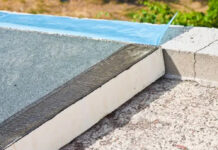Those gutters and downspouts on your roof aren’t there for show. They keep your home dry and in good shape. They direct rainwater away, so gutters and downspouts prevent all kinds of potential issues, like damaging your foundation or even causing roof problems.
In this post, we’ll give you some tips or two on keeping them operating like clockwork so your home stays protected year after year.
What are gutters and downspouts?
Gutters and downspouts are crucial parts of your roofing system. They manage the flow of water around your home. When it pours down with rain, gutters collect the water running off your roof and channel it to the downspouts.
These downspouts then take control, making sure the water is moved away from your home’s foundation. This helps stop water from pooling around your house, which could cause serious structural problems if left unchecked.
Usually, gutters are on hand in various shapes and sizes to fit different homes and styles. You can get them in high-degree PVCu, vinyl, aluminium, or steel. Downspouts direct the water away and also help cut down soil erosion while protecting your landscaping.
However, it’s important to install them correctly. Equally critical is maintaining them regularly for the health of your home. After all, you want to avoid more expensive repairs in the future. They might seem humble, but their role in protecting your house from water damage is anything but minor.
The importance of proper gutter installation
Getting your gutters installed the right way is essential. Think about it – if they’re not angled correctly, water won’t flow properly. That could mean pooling water, and, over time, that leads to damage. Not just to your gutters, but potentially to your home’s foundation and walls, too.
Getting them installed properly also guarantees your gutters are securely attached. No one wants gutters sagging or, worse, falling off during a downpour. Also, when done right, they’ll look tidy. They’ll complement your home rather than detract from it. Gutters protect your home and keep it looking sharp.
Materials and types of gutters
If you’re thinking aboutguttering for your home, you must pick the right type. Nobody wants to deal with water damage from a poorly chosen gutter system. Over here at eRoofing, we offer round and square line guttering. And each has its own set of benefits.
Round line guttering
Ourround line gutters, famed for their sleek, clean look, fit perfectly with modern architecture. They have a semi-circular shape that allows water to flow smoothly, reducing the chance of blockages and making maintenance a breeze.
Square line guttering
On the other hand, oursquare line guttering is great for areas with heavy rainfall. Its angular design looks sharp and also holds more water. So, it’s incredibly effective during those big storms. Plus, they’re easy to install, thanks to pre-lubricated seals and a handy clip system that snaps right into place.
And if you’re looking to keep your gutters clear of leaves and debris, check out theHedgehog Gutter Brush. It’ll keep things flowing smoothly.
Updating your current home? Sorting out the details for a new build? Either way, it’s essential to pick the right gutter material and type to keep your home dry and looking good. We have countless colours and sizes, so you’ll no doubt find something that matches your home’s style here at eRoofing.
Choosing the right downspouts
So you have your gutters sorted, but what about downspouts? These are equally vital because if they’re not up to snuff, all that proper gutter installation won’t mean much. Downspouts direct the water away from your home’s foundation and avert water damage and soil erosion.
When it comes to picking the right downspout, think about the volume of water they’ll need to handle. Then match that to your gutter system. They come in a whole gamut of sizes and shapes. So make sure you get one that fits your gutters well.
You’ll also want to think about material and colour. They must balance the exterior of your house and your new or existing gutters. And, of course, they should direct water into a drain or a safely designated area, not just spout off any old place.
As well as being functional, appearance matters too. A well-chosen downspout will blend brilliantly with your home’s style, so everything looks great and is well put together.
Top tips for keeping gutters and downspouts looking good
Keeping your gutters and downspouts in tip-top shape is as much about good housekeeping as it is about protecting your home. When you look after these components properly, there won’t be any blockages that can lead to water overflow and deterioration.
So, what should you be doing?
Firstly, clear out those leaves and debris at least twice a year—once in the spring and again in the autumn. This straightforward job can save you a lot of trouble later on. If you’re not too keen on clambering up ladders, install gutter guards to keep the debris out in the first place.
Then, look for any signs of sagging or detachment. If your gutters aren’t attached tightly, they can’t guide water successfully. So check everything’s firmly in place once a year, especially after a thunderstorm.
As for downspouts, ensure they’re directing water away from your foundation rather than just dumping it next to your walls. A bit of preventative care goes a long way in keeping your home dry and damage-free.
Common issues and how to fix them
Sometimes, gutters don’t do their job properly. Perhaps water spilled over during a rainstorm or you spotted some sagging sections. These are common issues, but fortunately, they’re repairable.
First, if water is overflowing, your gutters might be clogged. A quick clean-out should do the trick.
Sagging gutters? Check the brackets. They might just need tightening, or you might need to replace a few if they look worse for wear.
If you notice leaks, usually, they can be sealed with a bit of gutter sealant from your local hardware shop. Checking regularly and quick fixes can stop these small glitches from becoming major bothers that harm your home.
Improving gutter systems with roof vents
Upgrading your gutter system doesn’t stop at just the gutters and downspouts themselves. Addingroof vents can also play a significant part. Proper attic ventilation can diminish the risk of ice dams in the winter, which can seriously mess with your gutter performance.
Fitting roof vents help regulate the temperature in your attic. This means it stops the build-up of ice under your shingles. Your gutters can do their job without having to battle against ice blockages.
Essentially, you want a system that works together to protect your home. Plus, well-ventilated attics can extend the life of your shingles and reduce energy costs, making this a win-win scenario.
The takeaway
Keeping your gutters and downspouts in check is key to protecting your home. They prevent water from pooling and make sure your home stays structurally sound and looks good, too.
So, don’t skip the significance of regular maintenance and the right setup.
Need a hand or some quality supplies? Don’t hesitate tocontact us here at eRoofing.





